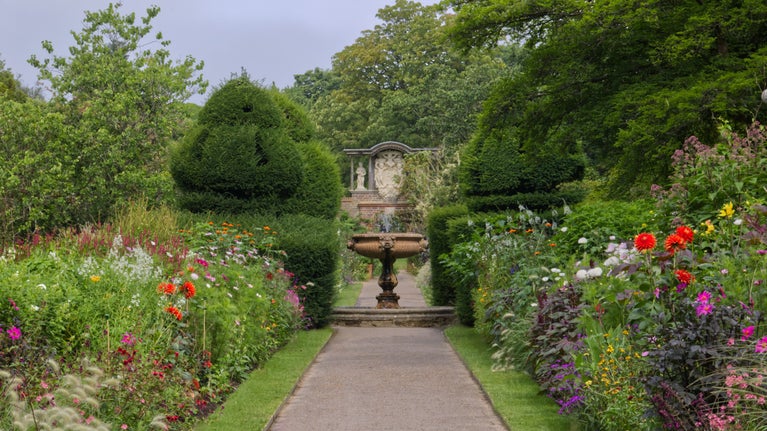
Gardens and landscapes
Find out more about the historical landscapes that the talented garden teams work hard to conserve at the places you love to visit.

Blooming prolifically from late summer until the first frosts, dahlias are the stars of the early autumn garden, with their myriad colours and forms. Explore the dahlia’s fascinating horticultural history, from its origins in Central America to the thousands of varieties trialled at Dyffryn Gardens in Wales in the early 1900s.
Mexico’s national flower, the dahlia hails from the mountainous regions of Central America. But the brilliantly coloured blooms we covet today have come a long way from these wild species.
In 1570, the scientist Francisco Hernández was sent to Mexico by King Phillip II of Spain to research the region’s natural history. Dahlias may have featured in his descriptions of over 3,000 plants then unknown to Europeans. However, it wasn’t until the late 18th century, when botany was developing as a science, that dahlias were first cultivated in Europe.
In 1786 a Spanish expedition returned to Mexico to complete Hernández’s work and dahlias were among the plant material sent back to Madrid’s Royal Botanic Gardens. It was here, in 1789, that a botanist and priest named Antonio José Cavanilles published the first descriptions and drawings of three dahlia species. Seeds and tubers from these dahlias were widely dispersed to botanists and plant enthusiasts across Europe in the early 1800s.
The first dahlias raised in Europe were single, open-centred flowers but horticulturalists soon discovered that when grown from seed, dahlias naturally hybridise, readily changing their colours and shape. This caused a particular headache for the plant taxonomists trying to keep up with naming new varieties.
Double dahlias were first bred in Germany in 1808 and growers quickly began selecting for specific traits. By 1820 around 100 dahlia varieties had been cultivated. In just 20 years that number had risen to 2,000.
When the Horticultural Society (later the Royal Horticultural Society) started regular flower shows in 1831, its September event was dedicated to dahlias. As they became the subject of serious competitions, the National Dahlia Society was set up in 1881. By the 1930s there were 14,000 named dahlia cultivars and over the last century almost 50,000 varieties have been listed.
The thousands of dahlia cultivars are classified by their different flower forms. There are 14 classification groups, including collarette, waterlily, single orchid (star) and fimbriated. Here are some popular examples.
When dahlias were trialled throughout the 19th century, the flowers were judged for their decorative qualities as specimens in the greenhouse or for floral arrangements.
Reginald Cory (1871–1934), the owner of Dyffryn Gardens near Cardiff, changed all that. A keen horticulturalist, he began the first trials of dahlias as garden plants in 1913, turning over most of his garden beds to thousands of different dahlias. These were judged by a joint committee of the National Dahlia Society and the RHS.
After the First World War, dahlia trials resumed and in 1923 Reginald sponsored the RHS Cory Cup for Dahlias. It continues today as a memorial cup awarded to the grower of the best hardy plant of garden origin.

Novelist Agatha Christie loved dahlias. From the 1950s onwards, she had an entire border dedicated to growing them at Greenway, her holiday home on the English Riviera in Devon. She and her family spent late summer days here, just as the dahlias were beginning to bloom.
Agatha even managed to weave the dahlia into one of her classic murder mysteries featuring the eponymous detective, Miss Marple. In her short story, The Four Suspects, Miss Marple's knowledge of horticulture leads her to recognise some familiar dahlia cultivar names that appear in a riddle. The first letter of each name spells out the acronym DEATH and she's quickly able to name the murderer.
After more than 100 years of intense breeding, tastes changed. By the early 1980s only around 20 per cent of the thousands of dahlia varieties that had been available in the 1950s were still being cultivated.
Fortunately, fashion has come full circle again. Christopher Lloyd's Exotic Garden at Great Dixter, created in the mid-1990s; the National Dahlia Collection and the restoration of many dahlia gardens and borders by the National Trust have contributed to dahlias being in vogue once more. You can see them in dedicated gardens, mixed borders, bedding and container planting in many of the gardens we care for.

Find out more about the historical landscapes that the talented garden teams work hard to conserve at the places you love to visit.
Tulips have been a popular flower for centuries. Find out where they came from, how they inspired the 'tulipmania' craze and learn about the different varieties you can still spot today.

Discover the history behind the daffodil, including how it came to be one of the UK's favourite flowers, where it came from and how to classify its many varieties.

Discover the evolution in garden buildings, from exclusive hothouses for rare new finds to the cornerstones of every garden today.

Explore how changing tastes influenced the style of gardens over the centuries and discover where you can find the best examples from each period at the places we care for.
